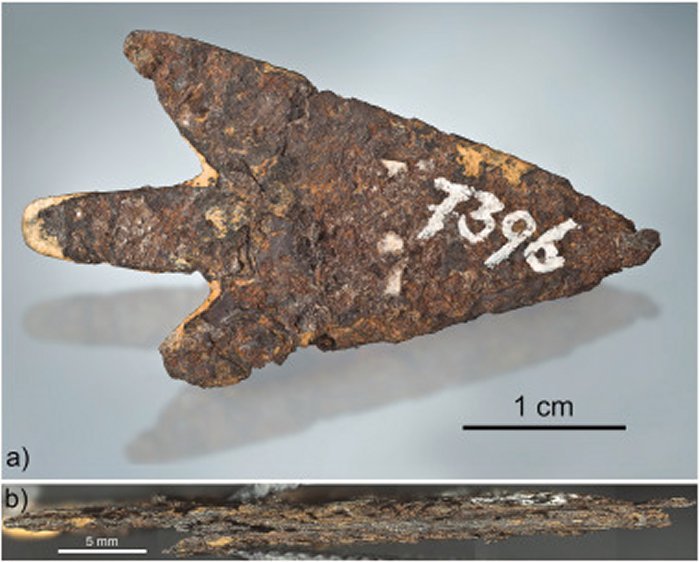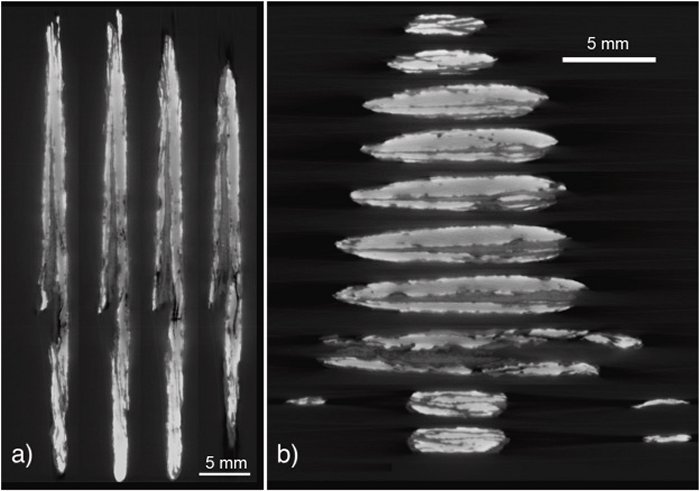Conny Waters – AncientPages.com – During a search for artifacts made of meteoritic iron, archaeologists accidentally found a Bronze Age arrowhead stored in the Bern History Museum’s collection.

Fig. 1. a–b. a) Overview of the Mörigen arrowhead. Note adhering bright sediment material. Remnants of an older label on the left of the sample number. Total length is 39.3 mm. PH๏τograph: Thomas Schüpbach. b) side view of the Mörigen arrowhead. Layered texture is well visible. Point is to the right. Image source: Credit: Journal of Archaeological Science (2023). DOI: 10.1016/j.jas.2023.105827
The collection ‘s artifacts were gathered in the greater area of the Lake of Biel, Switzerland.
A single object made of meteoritic iron has been identified, and its meteoritic origin is definitely proven. The arrowhead with a mᴀss of 2.9 g, was found in the 19th century in the late Bronze Age (900–800 BCE) lake dwelling settlement of Mörigen, Switzerland.
The study revealed that the Mörigen arrowhead is not made of iron from the nearby Twannberg strewn field, researchers say, instead it possibly originates from the Kaalijarv meteorite, Estonia.

Fig. 2. a–b: X-ray tomographic sections of the Mörigen arrowhead. a) shows four sagittal sections, b) shows 10 transversal sections. Brightest (=densest) areas correspond to metallic iron, brightness of iron metal is variable due to flatness of the object. The layered structure and fractures filled with iron (hydr)oxides/sediment material resulting from oxidative volume expansion are well visible.
Kaali is a group of nine meteorite craters in the village of Kaali on the Estonian island of Saaremaa. According to most recent estimations , the formation took place shortly after 1530–1450 BC; however, the impact is believed to have happened in the Holocene period, around 3,500 years ago.
“Among just three large European IAB iron meteorites with fitting chemical composition, the Kaalijarv meteorite (Estonia) is the most likely source because this large crater-forming fall event happened at ∼1500 years BC during the Bronze Age and produced many small fragments,“ they write in their paper.
Metallic iron was available to humans in the form of rare meteoritic iron before the smelting of the metal from oxide ores started.
The use of meteoritic iron for the fabrication of objects in pre-Iron Age times in Eurasia and northern Africa is known from finds in Turkey, Greece, Syria, Iraq, Lebanon, Egypt, Iran, Russia and China.
In central Europe, meteoritic iron artifacts are not frequently discovered. Earlier archaeological excavations only revealed two Czestochowa-Rakowa bracelets, and the Wietrzno axe.
“In total, only 21 find complexes (not all verified with modern methods) comprising a maximum of 54 individual objects of pre-Iron Age meteoritic artefacts were previously known from Eurasia and northern Africa.”
As part of this study, archaeological collections in Switzerland with many objects …The aim was to identify potential objects made of meteoritic iron from the nearby Twannberg iron meteorite strewn field.
Many different objects from the area of Lake of Biel were analyzed using a portable X-ray fluorescence (pXRF) analyzer.
According to the researchers, no object made of the Twannberg iron meteorite was identified during their study, and it means that the unearthed arrowhead made of a evidently different iron meteorite.
The Mörigen arrowhead is a very flat object (aspect ratio 15.1, after correction for thickness increase due to oxidation ∼20). However, primary shapes of meteoritic iron are never as flat, even in the case of “shrapnels”, which form due to explosive disruption on impact.
Thus, the flat aspect of the object must be due to the artificial deformation of an originally less flattened object, either due to H๏τ or cold working. This is consistent with the layered nature of the X-ray tomographs, most likely resulting from a deformed Widmanstätten pattern.
Cold-working of meteoritic iron is well documented from Greenland, where it has been the only method over possibly 1000 years (∼800–1800 AD) for preparing tools from the Cape York meteorite.
The researchers also observed “variation in nickel concentrations (standard deviation of 22%) is much larger than of measurements on un-oxidized metal surfaces, most likely due to oxidation and possibly partial element mobility on the surface of the object. In addition to the typical meteoritic elements Fe, Ni, Co, Ga and Ge (Cr < 52 ppm, average detection limit), relatively high concentrations of As and Cu, not typical of iron meteorites, were also etermined.
High concentrations of lead were measured only in the area of the white numbering, indicating the use of Pb-rich pigment for sample labeling,” the paper states.
Paper
Written by Conny Waters – AncientPages.com Staff Writer





